AMERICAN RESILIENCE: How 5 industries bounced back from 9/11, hurricanes, and the Great Recession — and what their success can teach us about hope after the coronavirus
Andy Kiersz,Shayanne Gal

- The coronavirus pandemic has devastated the American economy.
- But the US is a resilient country, and we have recovered from tragedy in the past.
- Business Insider looked at five industries that have been particularly hard hit by the economic effects of the outbreak, and how they survived and thrived after past calamities.
The coronavirus pandemic has unraveled the very fabric of American life.
More than 2.6 million Americans have had confirmed infections, and it's led to over 120,000 US deaths. Those numbers continue to rise.
In addition to the public health toll, the outbreak has had catastrophic consequences for the US economy. Businesses across the nation shuttered in response to the outbreak and the stay-at-home lockdowns intended to curb the spread of the disease.
Over 47 million Americans in total have filed for unemployment benefits over the last 14 weeks. Restaurants and stores have emptied out. Millions have canceled travel plans, radically altered their working conditions, and struggled to balance remote jobs with caring for relatives or children kept home from closed schools.
Although the situation is extremely dire and it's hard to recall an overwhelming public health and economic catastrophe of this magnitude, America is a resilient nation. It has overcome tragedy before.
An essential part of America's resilience is our ability to get back to work and rebuild our communities after a disaster. To that end, Business Insider took a look at five industries that have been particularly hard-hit by the coronavirus, and compared the current crisis to another disaster that field confronted and overcame. These examples of recovery show how time and again, Americans have come together to rebuild and recover in the face of great loss, and how we can do so again after this historic pandemic.
We've illustrated the past and current crises using one of our favorite media: charts and graphs. The best way to capture the magnitude of a disaster is to see it through the sweeping numbers involved. Hard facts and data are crucial in understanding and recovering from a crisis, and visualizing those statistics helps give the perspective needed to learn from the past.
Read on to see how those industries recovered and what could happen to them now:
resilience restaurants tourism hurricane katrina banner
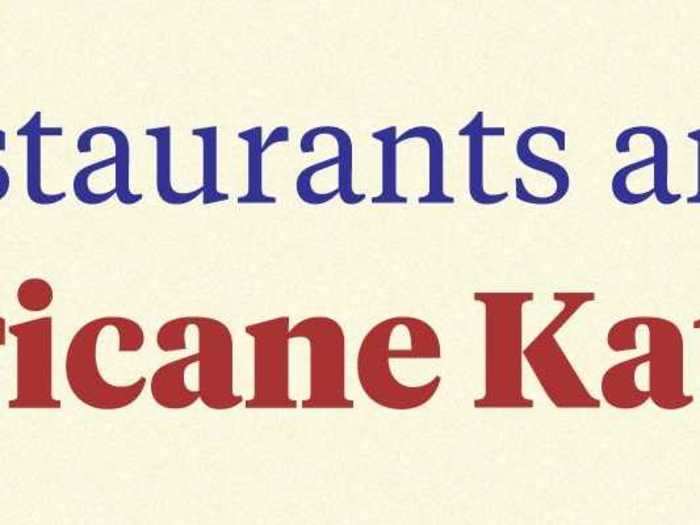
Hospitality and entertainment industries, especially bars and restaurants, have been hit particularly hard during the coronavirus pandemic.
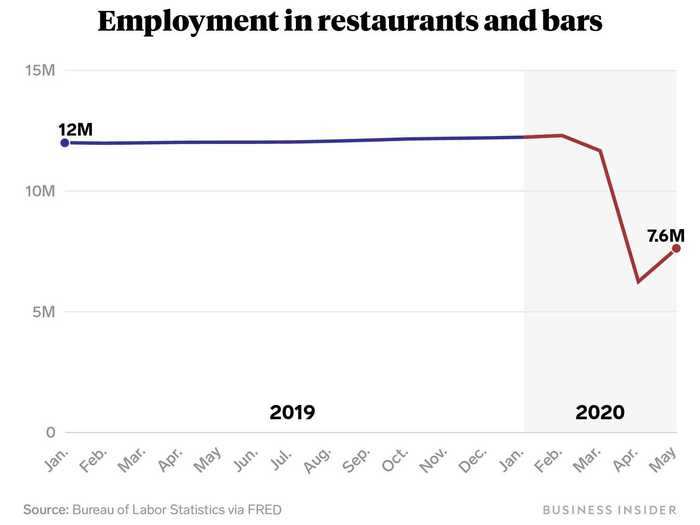
As US coronavirus case counts began their rapid rise in March, cities and states across the country started to implement social-distancing and lockdown orders to delay the spread of the disease. Those orders shuttered what were deemed "nonessential" businesses of all kinds — places that weren't viewed as needed to confront the immediate needs of the crisis and keep the basics of society running, ranging from hair salons to movie theaters and art museums.
Restaurants and bars were particularly hard-hit by these measures. According to the Bureau of Labor Statistics' April jobs report, as shown in the above chart, employment in food services and drinking places fell by nearly half between February and April.
While there was a partial rebound in restaurant and bar employment in May, coinciding with lockdowns being lifted or loosened in most parts of the country, the sector is still very far from a full recovery.
A new spike in cases in recent weeks, particularly in Southern and Western states, has threatened reopening plans.
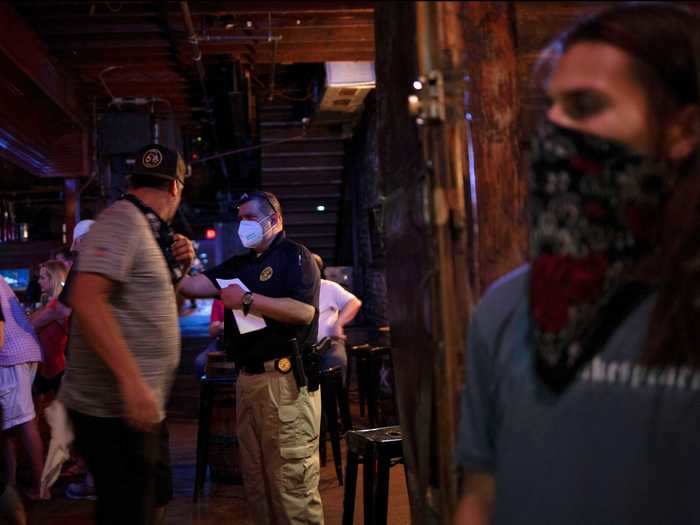
On June 25, Texas Gov. Greg Abbott announced a pause on the state's reopening, which had been steadily progressing since late April.
Arizona went a step further and announced a second round of orders to close businesses including bars, movie theaters, and gyms, which had all been allowed to reopen since May 15.
Businesses like restaurants and bars that involve lots of close physical proximity in enclosed spaces will likely struggle to safely reopen as long as the virus remains a threat.
Hurricane Katrina devastated New Orleans 15 years ago. The city is heavily dependent on tourism.
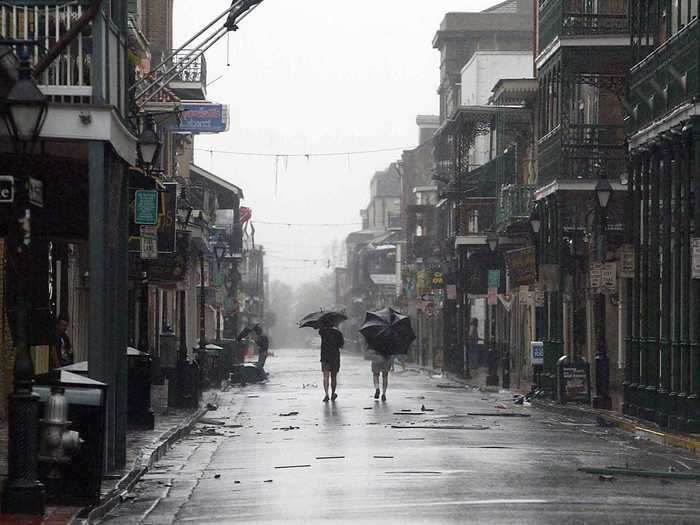
The Big Easy and its fabled nightlife and music scene have drawn tourists from around the world for decades. According to a report from New Orleans & Company and the New Orleans Tourism Marketing Corporation, over 18 million people visited the city in 2018.
In August 2005, Louisiana and its neighboring states were devastated by Hurricane Katrina. Levees in and around New Orleans failed from the storm, flooding large swaths of the city. Over 1,800 people were killed during the storm and the subsequent flooding, according to a CNN retrospective.
The hurricane was one of the worst natural disasters in US history.
Restaurant employment collapsed in the aftermath of the hurricane.
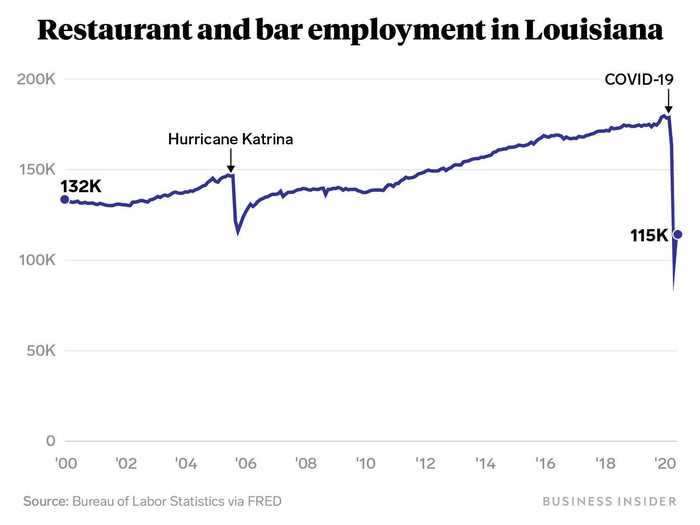
New Orleans' tourism-driven economy was severly affected by the disaster. Employment in restaurants and bars across Louisiana fell by 21% between July and September 2005, as shown in the above chart.
In the years after the hurricane, the city rebuilt itself, and the hospitality sector largely recovered. By 2011, employment in restaurants and bars had surpassed the pre-Katrina high, and tourists and visitors came back to New Orleans.
New Orleans' recovery didn't arrive evenly for all residents, however.
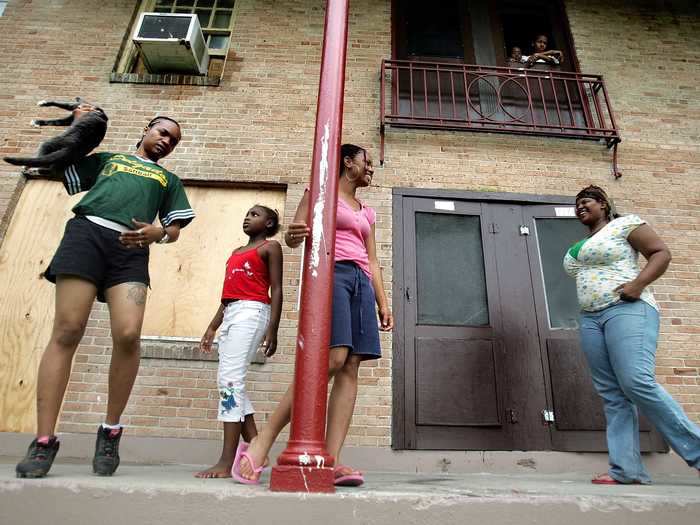
While New Orleans was largely able to rebuild, serious inequalities revealed by the disaster still remained raw. Many of the hardest-hit areas were home to predominantly Black populations. A 2015 Kaiser Family Foundation study found that even a decade after the storm, Black New Orleans residents still faced greater economic hardships and had a more pessimistic view of the city's recovery than their white neighbors.
The coronavirus pandemic has exacerbated similar racial and socioeconomic fault lines in the country as a whole. Severe-case and death rates have hit Black communities and other communities of color harder than white Americans, largely owing to long-term inequalities in access to healthcare and other environmental factors.
Still, New Orleans' rebound provides hope.
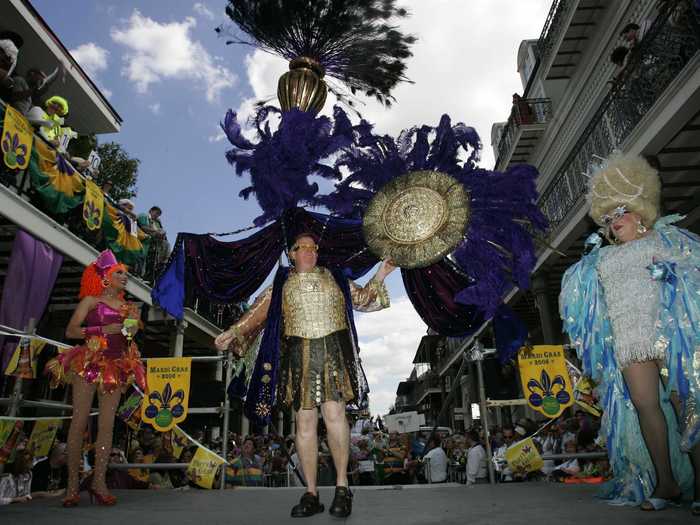
The return of hospitality and tourism to New Orleans shows that a recovery in these sectors is possible, even in the wake of something as devastating as Katrina or the coronavirus.
However, policymakers and business owners will need to be careful to make sure that all Americans are included as the country rush to reopen.
resilience airlines september 11 banner

Like restaurants, airlines have been devastated by the pandemic.
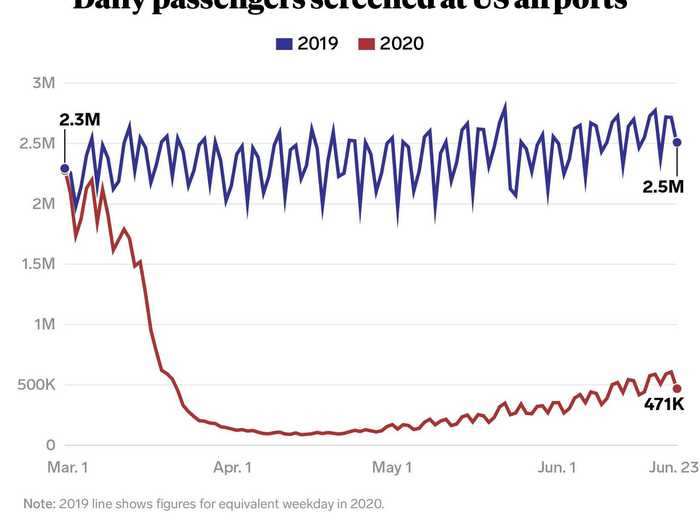
According to statistics provided by the Transportation Security Administration, the number of Americans passing through airport security on a daily basis fell by 96% between the beginning of March and mid-April.
Stay-at-home orders and concerns over the possibility of virus transmission in the closed confines of an airplane helped lead to the sharp decline, and several airlines have already shut down or entered bankruptcy.
In April, airlines and the Trump administration reached an agreement for a $25 billion bailout, according to The New York Times.
While many airlines have started some recovery in the number of passengers flying as lockdowns lift, a second wave of the outbreak could lead to a renewed collapse in air travel in the coming months.
The 9/11 terror attacks shook the world, and changed air travel forever.
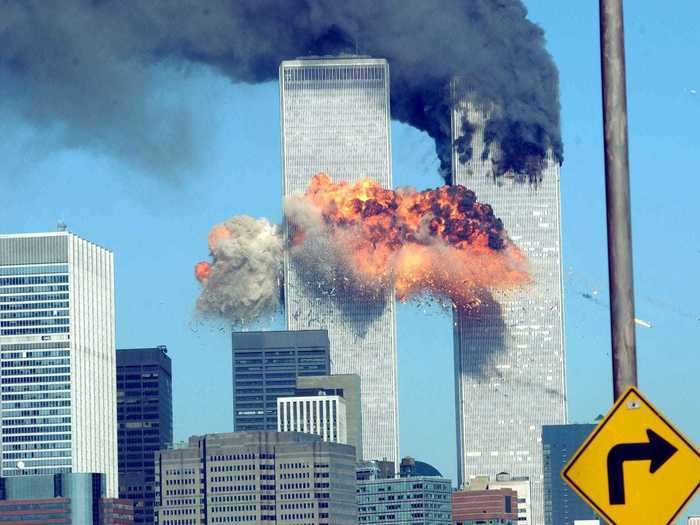
On September 11, 2001, four airplanes were hijacked and crashed into the World Trade Center in New York, the Pentagon in Washington, DC, and a field in rural Pennsylvania.
This was the worst terrorist attack on US soil in history, and nearly 3,000 Americans died that day.
Air travel declined across the country after the attacks.
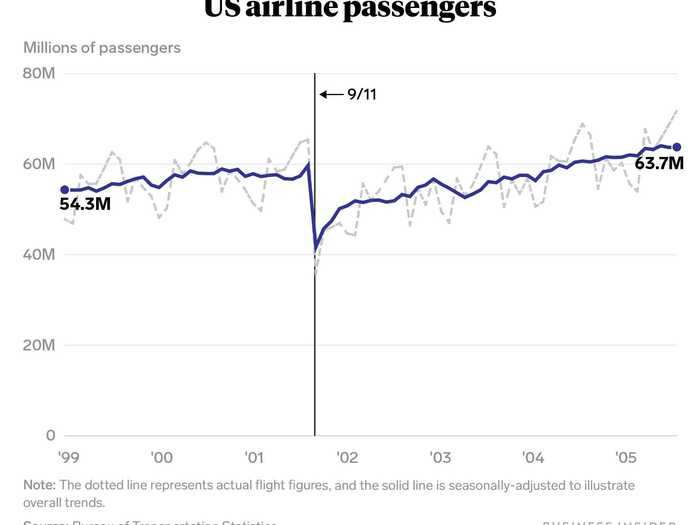
In the immediate wake of the attacks, all US flights were grounded by the FAA for several days. But as the chart above indicates, air-passenger volumes remained subdued long after.
Despite the drop in air travel, passenger volumes eventually recovered. Within two weeks of the attacks, the federal government threw a $15 billion lifeline to the airlines, helping the ailing industry stay afloat.
The post-9/11 recovery in the airlines, however, came with radical changes in how Americans viewed and experienced security while flying.
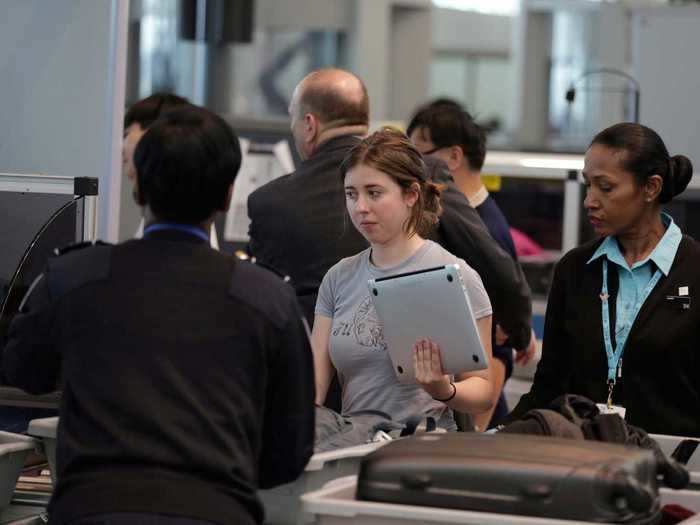
The Transportation Security Administration was created to increase security screenings at airports. As anyone who has taken a plane in the last two decades knows, those screenings are far more intensive than they were before the attacks.
Although the heightened security frustrations are a perennial headache for travelers, Americans eventually took to the skies again, and they likely will make a similar return after the pandemic.
Just as the 9/11 attacks led to a new normal of tightened airport security, the coronavirus pandemic could lead to more disease-fighting precautions when frequent air travel resumes.
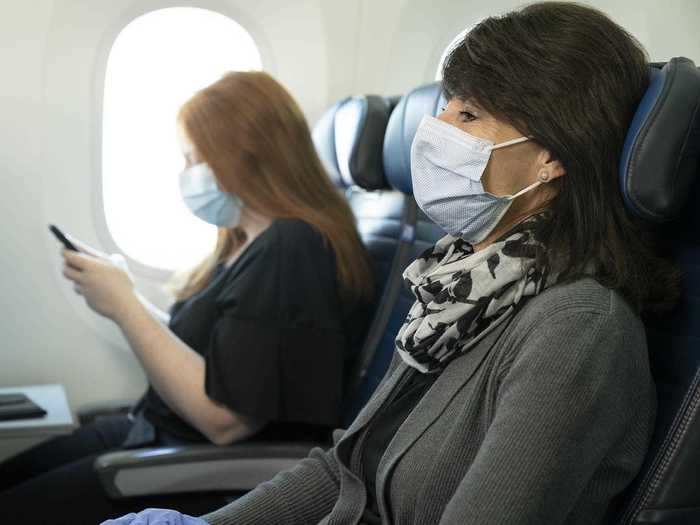
Many airlines have taken precautions like keeping the number of passengers on planes far below capacity, leaving open seats to better allow for social distancing. Masks and temperature checks are now common, and cleaning procedures on planes and in airports have become more stringent.
Just as the nature of airport security radically changed after 9/11, some of the precautions taken during the pandemic could become a routine part of air travel. And just as Americans started flying again in the years after the terrorist attacks, they will likely return to the skies en masse once the pandemic curve has flattened further.
resilience housing real estate bubble banner
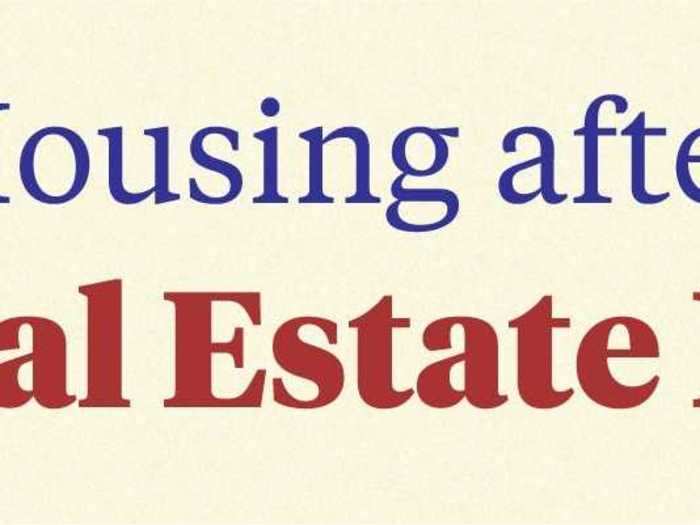
The future of the real estate market after the pandemic is mired in uncertainty, with home sales plummeting over the last few months.
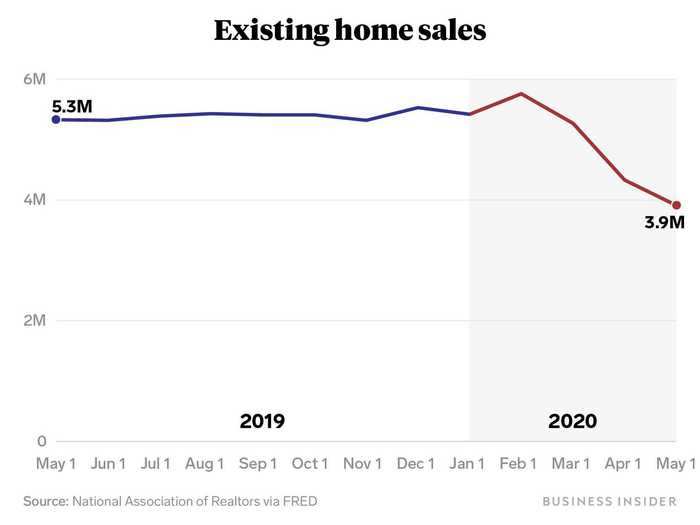
The pandemic has disrupted real estate markets. As the above chart shows, sales of existing homes have plummeted in the last two months.
Uncertainty hangs over the future of urban real estate. While there has been a recent uptick in listings in the Manhattan residential market, volume is far lower than it was the previous spring and summer, usually the peak seasons for homebuyers every year.
Similarly, in California's Bay Area, suburban markets like Oakland have been recovering somewhat faster than the urban core of San Francisco, suggesting that many potential homebuyers are rethinking living in big dense cities and are instead considering suburbs or smaller cities.
Rental markets have been chaotic as well amid the sharpest economic downturn in decades.
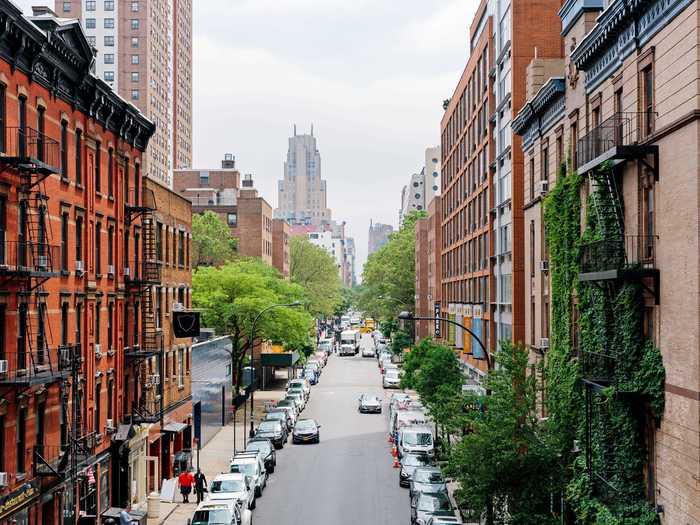
A survey of New York renters by PropertyNest suggested that over a third didn't have enough money to pay rent in June. A New York State moratorium on evictions recently ended, and it could result in thousands of cash-strapped New Yorkers losing their homes, according to The New York Times.
The last big downturn in the US real-estate market was after the mid-aughts housing bubble.
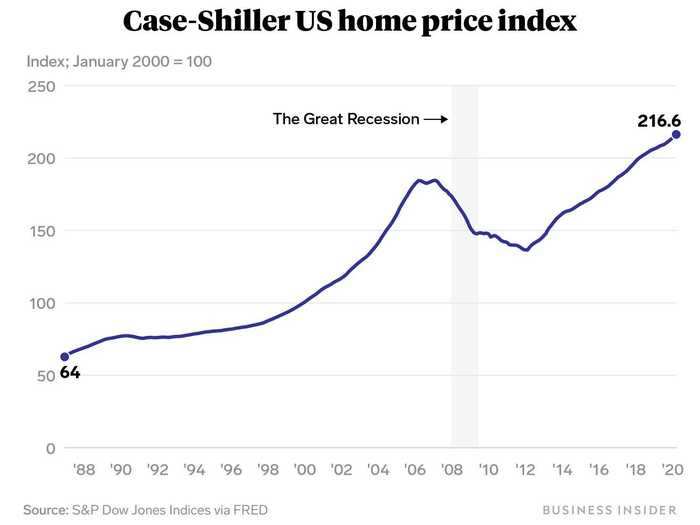
In the first years of the 21st century, housing prices in the US skyrocketed. Looser lending standards and investors buying houses to "flip" them for a profit helped fuel the bubble, according to a 2018 NPR retrospective.
That all collapsed near the end of the decade. Home prices started falling in early 2007, as can be seen in the above chart, representing an index of prices across major metropolitan housing markets. The Case-Shiller index tracks changes in housing prices in the US, and is calibrated so that a value of the index at 100 represents average home values as of January 2000.
The end of the housing bubble was one of the pivotal events leading to the Great Recession, which left the US economy in tatters a decade ago.
When the bubble burst and the economy went south, millions of Americans were unable to pay their mortgages.
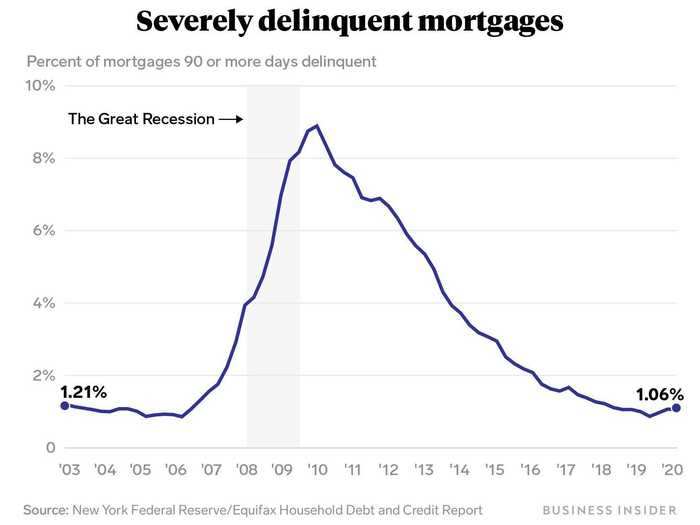
Falling housing prices and rising unemployment in the wake of the 2008 financial crisis led to millions of Americans struggling to pay their mortgages and a massive wave of foreclosures. The recovery from the crash was slow and grinding, with housing prices only returning to their early 2007 peak in late 2016.
While the recovery after the crash was slow, the growing US population still needed places to live, and so the housing market did eventually come back.
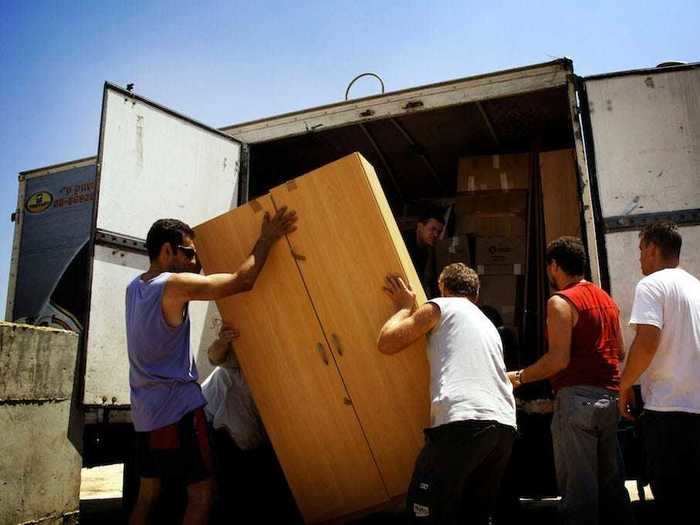
While real estate markets will undoubtedly be quite different after the coronavirus pandemic recedes, and some of the hardest-hit areas may be less desirable to renters and homebuyers, it's likely that within the next several years housing in most places will be well in demand once again.
Read more: We found the 30 best American cities to live in after the pandemic
resilience nyc subway hurricane sandy banner
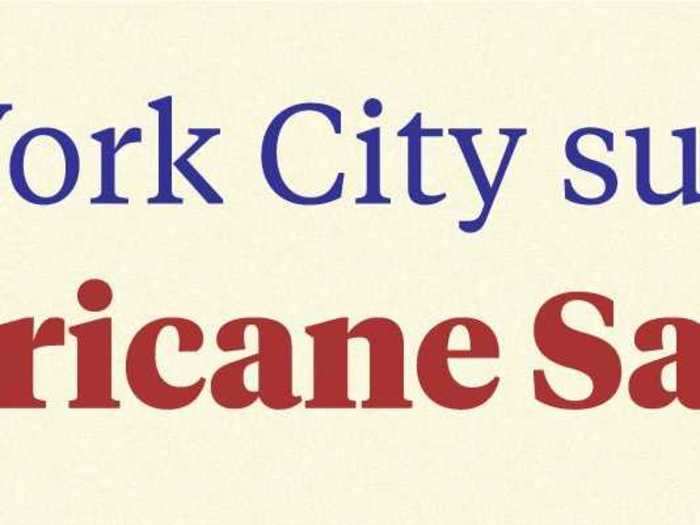
Public transportation has also been affected by the pandemic, as people avoid crowded buses and trains.
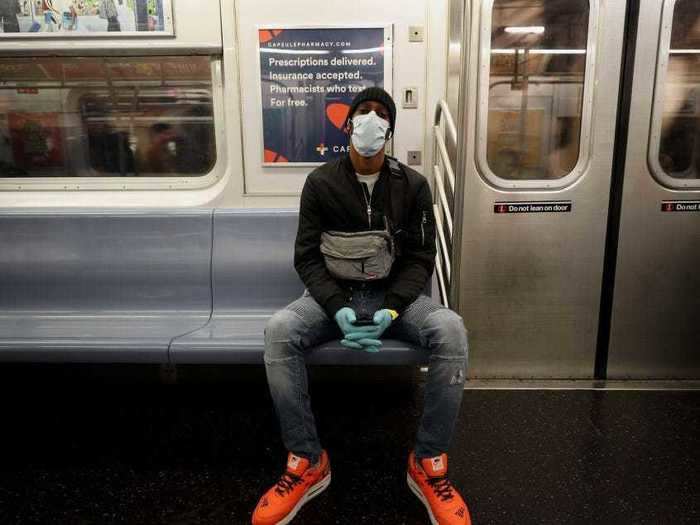
Public transportation is a key artery in many cities, with subways, trains, and buses getting people where they need to go. The pandemic has hampered these systems across the US.
Enclosed, tightly packed spaces (like crowded buses or trains) are believed to be among the most common locales for large-scale spread of the coronavirus, likely dissuading many would-be riders from taking transit.
Further, efforts to mitigate the spread of the virus and the closure of offices across the country have led to many workers cutting out their commute entirely by working from home.
Public transit ridership in New York City has collapsed, with public health fears around the risk of transmission in an enclosed space in which it's hard to social distance.
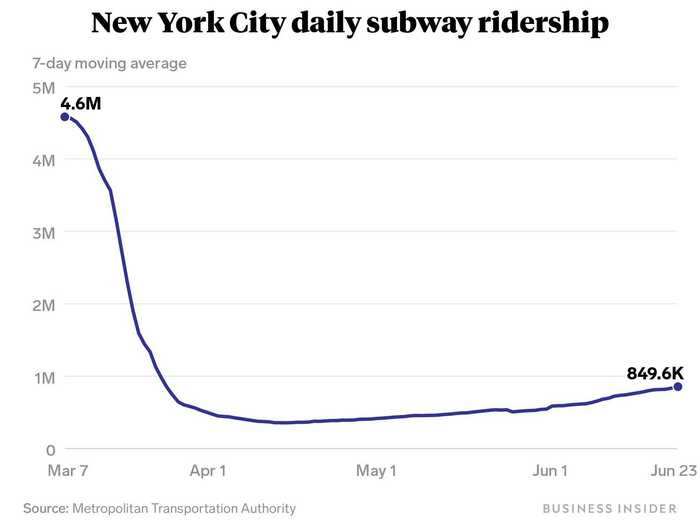
New York City was one of the first major epicenters of the coronavirus pandemic in the United States. By early April, the city was experiencing over 5,000 new confirmed cases per day on average.
After stay-at-home orders went into effect in mid-March, ridership on the New York City subway plummeted. Even as the lockdown has begun to ease somewhat, most New Yorkers not in essential jobs are continuing to avoid the trains.
The workers who keep New York City moving have been hit especially hard by the pandemic. According to a report from local news site The City, as of early June nearly 2,000 subway workers had been infected with the coronavirus. The report also said that as of that time, 127 subway, commuter rail, and bus workers had died from the disease.
The pandemic has led to new safety and hygiene measures in NYC's public transit.
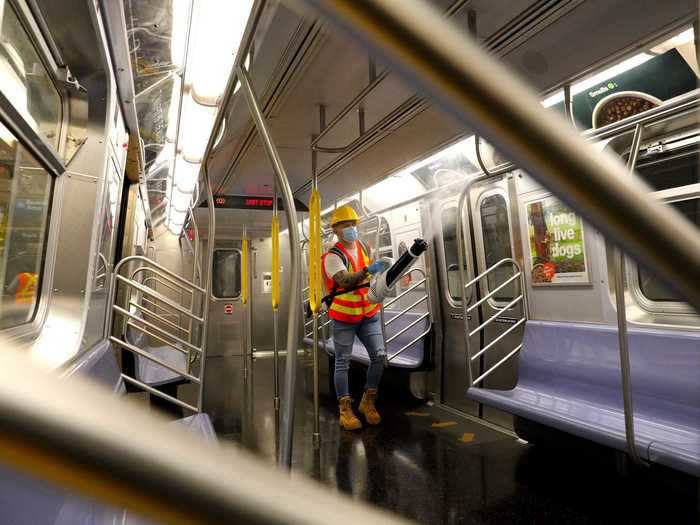
The Metropolitan Transportation Authority is the governmental agency that manages public transportation in the New York City metro area, including buses, the subway, and commuter railroads out to the suburbs. The MTA has taken several measures since the outbreak began. Late-night subway service has been curtailed to allow the MTA to clean trains daily, masks are required for all passengers, and social-distancing reminders have been added in stations.
As with airplanes, subway cars represent the kind of crowded, closed-in space that appears to be a particularly fruitful place for the coronavirus to spread. Between ongoing fears of the virus and changes in commuting patterns as many workers have switched to working from home, it may be a while before subway ridership returns to normal.
After Hurricane Sandy in 2013, large swaths of the NYC subway system were flooded and shut down.
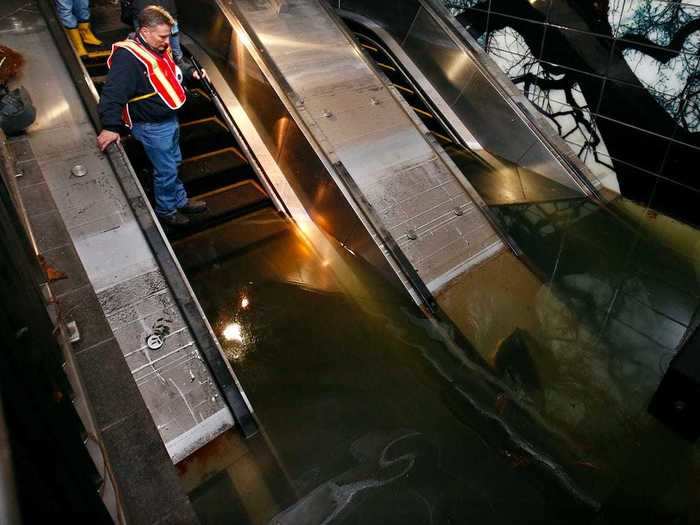
The MTA is no stranger to severe challenges to the NYC subway system. In October 2012, Hurricane Sandy flooded miles of subway tunnels and stations, including seven tunnels that run under the East River, connecting Manhattan to Brooklyn and Queens, according to The New York Times.
The entire subway system was closed prior to the storm, with only limited service available in the days after as repair crews pumped water out of flooded tunnels and made sure that the transit system was safe for use.
Parts of the system, however, took years to repair.
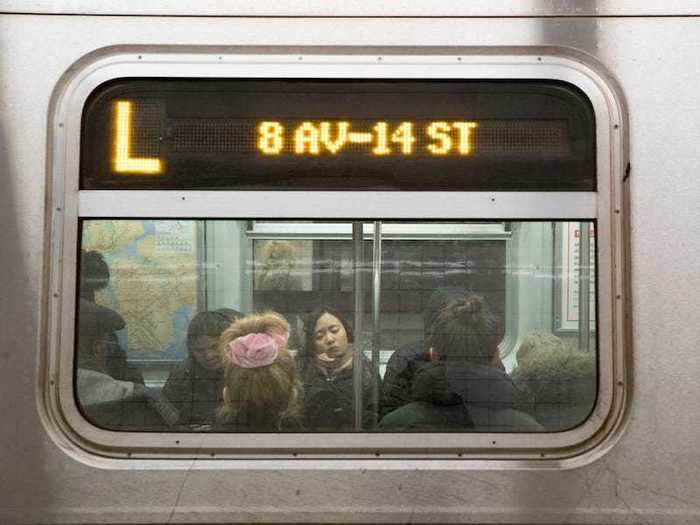
Although much of the subway came back online in the weeks after the storm, the road to full recovery was long and difficult.
The tunnel carrying the subway's L train line, a key connector between Brooklyn and Manhattan, suffered serious structural damage from flooding after the hurricane. The project to reinforce that tunnel was only completed in April 2020, seven and a half years after Sandy.
resilience auto industry great recession banner
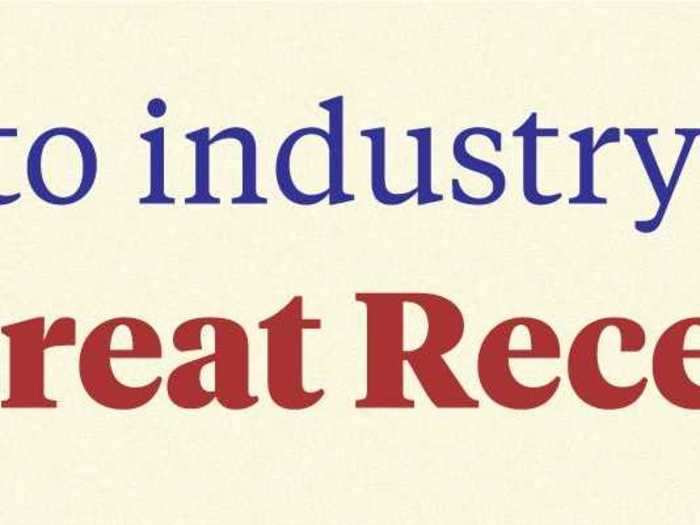
Cars are one of the biggest individual purchases many Americans make. In the wake of the recession caused by the pandemic, auto sales have tumbled off a cliff.
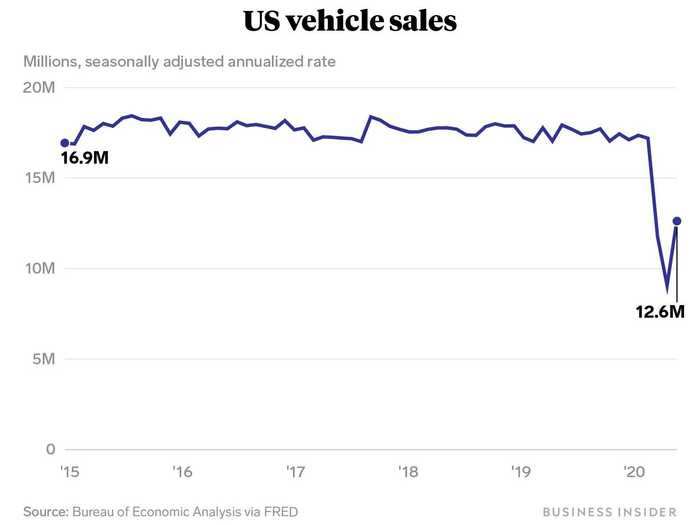
With unemployment at historic highs and much of the country's economy in a deep freeze, it is not surprising that households are putting off big purchases like cars. The above chart shows monthly auto sales at a seasonally-adjusted annualized rate, or an estimate of how many cars would be sold in a year given the number of cars sold that month.
That rate plummeted by nearly half between February and April. Like many other major economic indicators, car sales increased somewhat in May, but remain far below pre-pandemic levels.
Along with auto sales, auto manufacturing has taken a big hit during the pandemic.
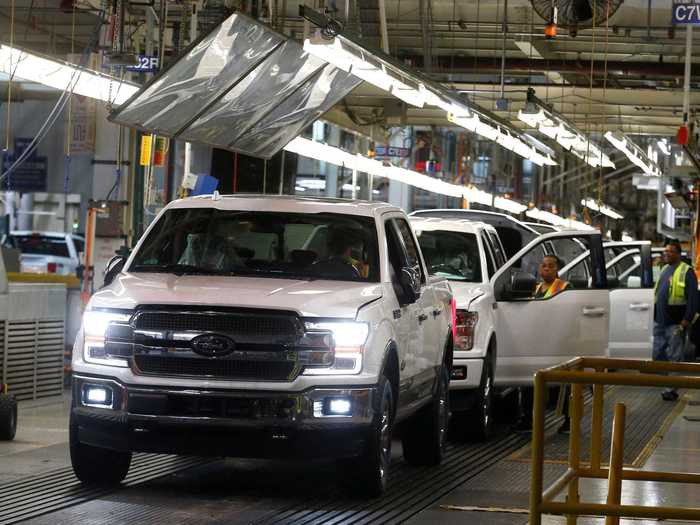
As case counts started rising, the big three automakers — GM, Ford, and Fiat Chrysler — all shut down their factories in late March. They began slowly reopening in May, according to The New York Times.
Auto manufacturing has been one of the industries that's seen the biggest drop in employment in the last few months.
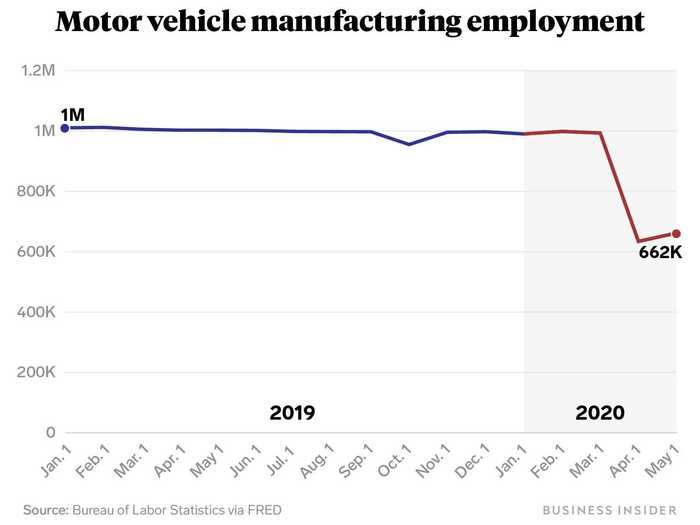
The auto-plant closures can be seen in the above chart of employment in motor vehicle manufacturing. Over 350,000 jobs were at least temporarily lost in the sector between February and April, and there was little recovery as of May.
In the Great Recession of 2008-2009, the auto industry was in similarly dire straits.
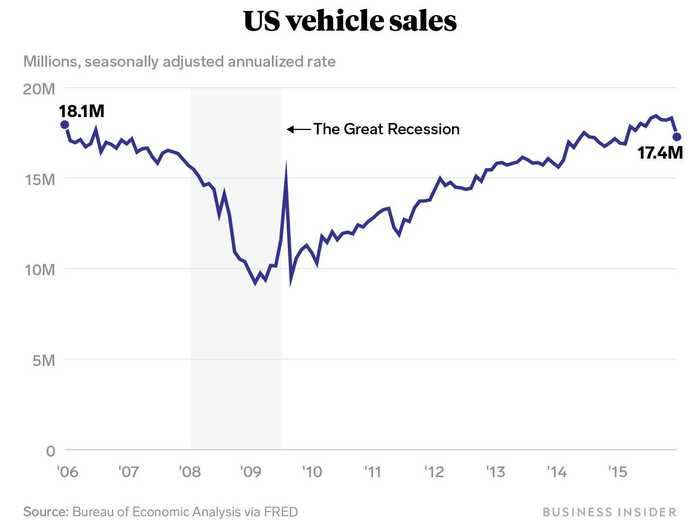
The Great Recession severly impacted the auto industry. The economic crash after the 2008 financial crisis led to a prolonged slump in auto sales, similar to the sharp decline happening now during the pandemic.
The brief uptick in sales in mid-2009 on the previous chart coincided with the Obama administration's 'Cash for Clunkers' program.
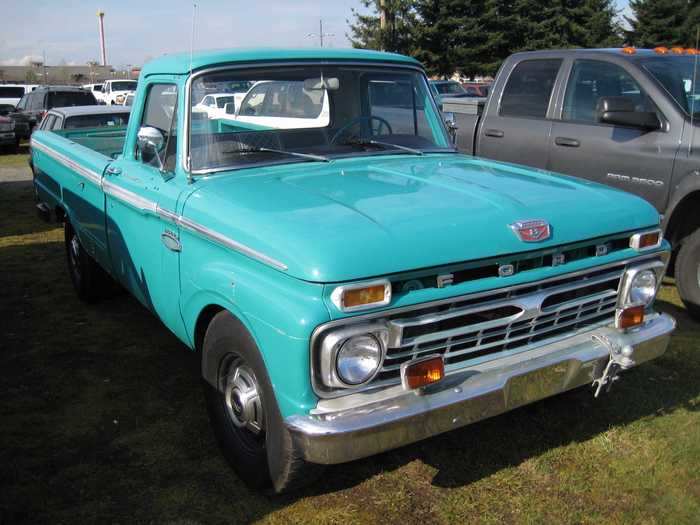
The program was part of the government's stimulus efforts to confront the Great Recession. According to Investopedia, the program "provided financial incentives to car owners to trade in their old, less fuel-efficient vehicles for more fuel-efficient ones."
The auto-manufacturing industry was on the verge of collapse, and required massive government support to survive.
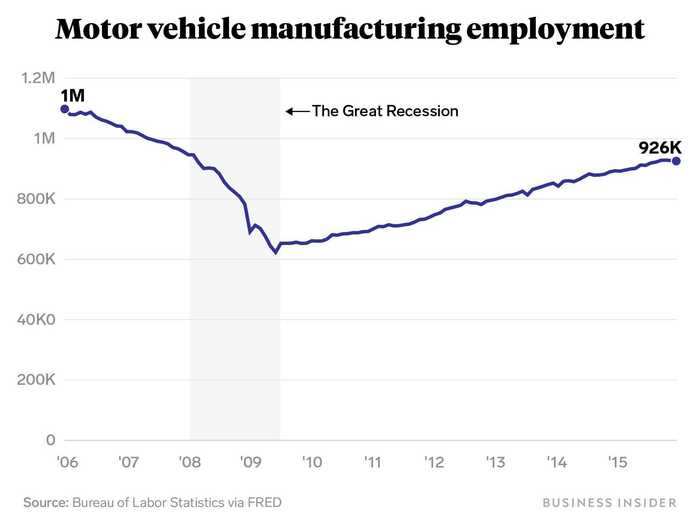
The automakers nearly collapsed during the Great Recession. Auto-manufacturing employment cratered and took several years to recover.
General Motors declared bankruptcy in 2009, leading to a government-backed reorganization that resulted in a new IPO in 2010. Collectively, the Big Three survived largely because of heavy government intervention. Around $80 billion in total was invested by the Bush and Obama administrations during the crisis.
The eye-popping auto-industry bailout largely worked.

GM emerged from bankruptcy and once again became a thriving automaker. Chrysler merged with Italian automaker Fiat, forming a global car-building giant.
Depending on how long the economic fallout from the pandemic lasts, and how deep the downturn ultimately ends up being, similar government-backed action could help save struggling industries in a similar fashion to what happened a decade ago.
The success of the auto bailouts suggests a potential role for the federal government in assisting the recovery from the pandemic.
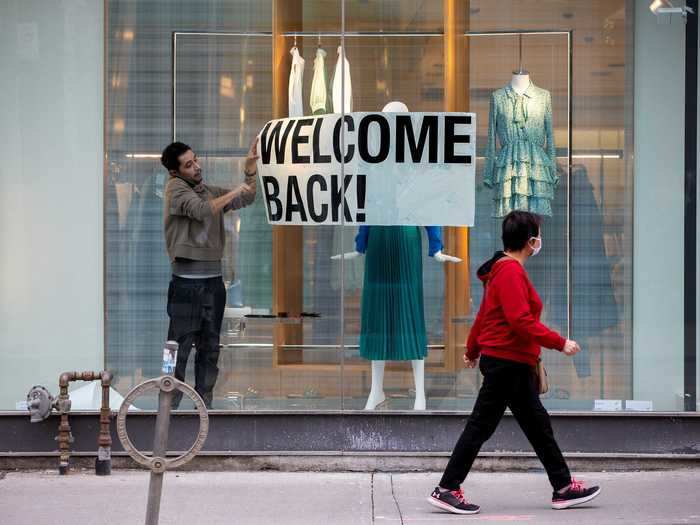
The federal government has already taken several steps to bolster the economy in the midst of the pandemic and the lockdowns. In April, Congress approved a $25 billion bailout for the airline industry.
The government has moved to help individuals and small businesses as well. The massive CARES Act stimulus package included a $1,200 check to most taxpayers and expanded unemployment benefits. A recent analysis suggests it helped keep 12 million Americans out of poverty.
The $660 billion Paycheck Protection Program, which provides loans to small businesses to help keep them afloat during the shutdowns, has also helped boost America's resiliency during this crisis.
However, more may be needed. A second wave of virus outbreaks has intensified in recent weeks, and many of the provisions of the CARES Act, including the generous unemployment benefits, are set to expire at the end of July.
Read more in our series on American resilience
READ MORE ARTICLES ON
Popular Right Now
Popular Keywords
Advertisement